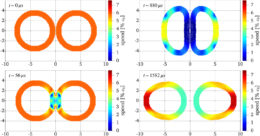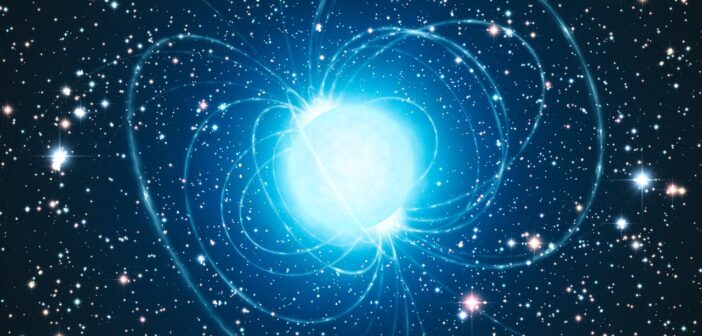The strongest material in the universe isn’t graphene or spider silk or diamonds — it’s the crystalline crust of a dead star’s core. New research explores how to adapt our fluid dynamics models to simulate this exotic material.
A Material Unlike Any Other
Nearly all of the visible matter in our universe is in the form of plasma, which researchers excel at simulating with fluid dynamics models. Solid objects often require a different modeling treatment, since solids have a property that plasmas lack: material strength, or the ability to resist cracking or deformation. Material strength is a critical property for the crusts of neutron stars, which are made of ions arranged in a crystal lattice. Neutron star crust is the strongest material in the universe, and a teaspoon of this superlative matter would weigh 5 tons if brought to Earth’s surface.
This immense strength means that neutron star crusts can’t be modeled with typical fluid dynamics models that don’t take material strength into account. In a recent research article, Irina Sagert (Los Alamos National Laboratory) and collaborators tackle the problem of modeling neutron star crusts with fluid dynamics models, allowing us to study this extreme material with greater accuracy.
Making a Solid Model
Sagert’s team used a smoothed-particle hydrodynamics code called FleCSPH to model waves in a neutron star’s crust. These waves are thought to explain some of the features observed in X-ray flares from neutron stars, and they might affect the gravitational-wave signal produced when neutron stars spiral toward a collision. While previous studies have used smoothed-particle hydrodynamics to explore the behavior of neutron stars, these simulations treated the stars as fluid through and through, including their solid crusts, which made probing these waves impossible. Sagert’s team’s model includes a solid crust atop a fluid core.

Snapshots of the colliding rubber rings. The color scale shows the particle velocity. Click to enlarge. [Sagert et al. 2023]
Challenges and Paths Forward
The team applied their model to the problem of toroidal waves in a neutron star’s crust. This presented several challenges:- The crust makes up just a tiny fraction of a neutron star’s total volume, so most of the computational power goes toward simulating the star’s fluid interior rather than its crust.
- In the simplest case, in which the neutron star has no magnetic field, there should be no friction between the crust and the core. Because of the way a smoothed-particle hydrodynamics model performs its calculations, though, there will always be some effective friction between the crust and the core in simulations.
- Despite its extreme density and strength, neutron star crust shares something in common with gelatin: it’s much more resistant to being compressed on all sides than it is to being torn apart by shearing. This property means that small numerical fluctuations in the crust’s density can grow large unless suppressed.
The team explored several way of overcoming these challenges, and the resulting model output showed promising agreement with analytical models. The quest to model neutron star crusts isn’t yet over, but Sagert and collaborators see a clear path ahead. Incorporating relativistic physics will open the door to accurate modeling of neutron star mergers and allow researchers to study neutron star collisions and enormous X-ray flares from cracking neutron star crusts more precisely than ever before.
Citation
“Modeling Solids in Nuclear Astrophysics with Smoothed Particle Hydrodynamics,” I. Sagert et al 2023 ApJS 267 47. doi:10.3847/1538-4365/acdc94


